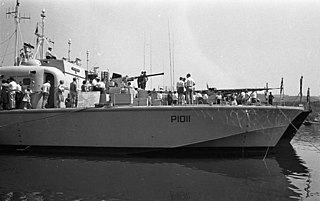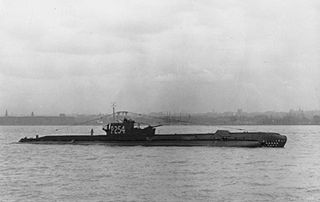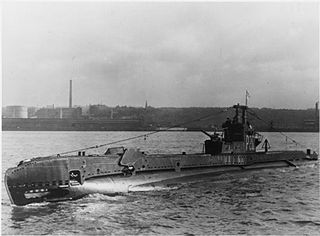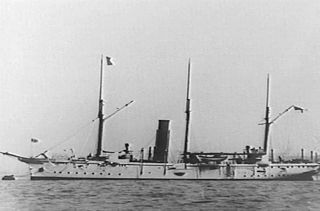
In naval terminology, a destroyer is a fast, maneuverable, long-endurance warship intended to escort larger vessels in a fleet, convoy, or carrier battle group and defend them against a wide range of general threats. They were originally conceived in 1885 by Fernando Villaamil for the Spanish Navy as a defense against torpedo boats, and by the time of the Russo-Japanese War in 1904, these "torpedo boat destroyers" (TBDs) were "large, swift, and powerfully armed torpedo boats designed to destroy other torpedo boats". Although the term "destroyer" had been used interchangeably with "TBD" and "torpedo boat destroyer" by navies since 1892, the term "torpedo boat destroyer" had been generally shortened to simply "destroyer" by nearly all navies by the First World War.

A torpedo boat is a relatively small and fast naval ship designed to carry torpedoes into battle. The first designs were steam-powered craft dedicated to ramming enemy ships with explosive spar torpedoes. Later evolutions launched variants of self-propelled Whitehead torpedoes.

The Beagle class was a class of sixteen destroyers of the Royal Navy, all ordered under the 1908-1909 programme and launched in 1909 and 1910. The Beagles served during World War I, particularly during the Dardanelles Campaign of 1915.

A motor torpedo boat is a fast torpedo boat, especially of the mid 20th century. The motor in the designation originally referred to their use of petrol engines, typically marinised aircraft engines or their derivatives, which distinguished them from other naval craft of the era, including other torpedo boats, that used steam turbines or reciprocating steam engines. Later, diesel-powered torpedo boats appeared, in turn or retroactively referred to as "motor torpedo boats" for their internal combustion engines, as distinct from steam powered reciprocating or turbine propulsion.

The motor gunboat (MGB) was a small, high-speed British military vessel of the Second World War, which was armed with a mix of guns, in contrast to the physically similar motor torpedo boat (MTB), whose main offensive weapon were torpedoes. The small size of the MGBs, and their high speed, made them difficult targets for German E-boats, though, like their opponents, they were limited by heavy weather, because they did not provide a stable-enough platform to aim the guns. The large number of guns meant the crew was relatively large, numbering as high as thirty men on the largest boats.

The Brave-class fast patrol boats were a class of two gas turbine motor torpedo boats (MTBs) that were the last of their type for the Royal Navy (RN) Coastal Forces division. They formed the basis for a series of simpler boats which were widely built for export.

HMS Selene was a S-class submarine of the third batch built for the Royal Navy during World War II. She survived the war and was sold for scrap in 1961.

HMS Solent was a S-class submarine built by Cammell Laird and launched on 8 June 1944 of the third batch built for the Royal Navy during World War II. She spent most of her career in the Pacific Far East, often in company with her sister ship, HMS Sleuth. Together they sank fifteen Japanese sailing vessels and the Japanese auxiliary minesweeper Wa 3. She survived the war and was sold for scrap in 1961.

HMS Supreme was a S-class submarine of the third batch built for the Royal Navy during World War II. She survived the war and was sold for scrap in 1950.

Coastal Forces was a division of the Royal Navy initially established during World War I, and then again in World War II under the command of Rear-Admiral, Coastal Forces. It remained active until the last minesweepers to wear the "HM Coastal Forces" cap tally were taken out of reserve in 1968. The division received more gallantry awards than any other branch of the Royal Navy during that period.

The Dale class were a class of replenishment oilers taken up for service with the Royal Fleet Auxiliary, supporting the Royal Navy during the inter-war period. They went on to see action during the Second World War and supported British and allied fleet units in Cold War conflicts such as the Korean War.
The Dark class, or Admiralty "Type A", were a class of eighteen fast patrol boats that served with the United Kingdom's Royal Navy starting in 1954. All were named with a prefix of 'Dark'. The class could be fitted as either motor gun boats or motor torpedo boats, depending on the type of armament carried. They were the only diesel engined fast patrol boats in the Royal Navy. The class was fitted with the Napier Deltic two-stroke diesel engine. This was of unique layout, an opposed-piston engine with a triangular layout of three banks, 18 cylinders in total.

HMS Archer was an Archer-class torpedo cruiser of the British Royal Navy which built by the Glasgow shipbuilder J & G Thomson between 1885 and 1888. She served on overseas stations, including operations off Africa, China and Australia. She was sold for scrap in 1905.

HMS Albrighton was a Type III Hunt-class destroyer built for the British Royal Navy. She entered service in February 1942, first carrying out an attack on German ships in the English Channel then taking part in the Dieppe Raid, rescuing survivors from the sinking destroyer HMS Broke. Albrighton was next assigned to search for and destroy the German auxiliary cruiser Komet, then escorted a convoy to Gibraltar in prevision of the Allied landings in North Africa. Between December 1942 and April 1943, she participated in the sinking of three more Axis ships with the First Destroyer Flotilla. During the Normandy Landings in June 1944, Albrighton served as a headquarters ship, then sank two German trawlers in the weeks after the invasion. After being converted to a destroyer in early 1945, she was damaged in a collision with a Landing Ship, then was assigned to the British Eastern Fleet. However, the war ended before she was deployed and Albrighton went into reserve.

HMS Teazer was an R-class destroyer which served with the Royal Navy during World War I. The destroyer was launched in April 1917 and, on trial, proved to be one of the fastest afloat, exceeding 40 knots. Attached to the Harwich Force, the ship supported the monitors Erebus, Terror and Marshal Soult in the bombardment of Zeebrugge in May 1918 and one of the final sorties of the war in the October following. The destroyer also took part in operations off the coast of Heligoland with a flying boat on a lighter, although the aircraft failed to take off. After the war, Teazer was kept in reserve until being sold to be broken up in 1931 following the signing of the London Naval Treaty that limited total destroyer tonnage.

HMS Thisbe was an R-class destroyer which served in the Royal Navy during World War I. The R class were an improvement on the previous M class with geared steam turbines to improve efficiency. Built by Hawthorn Leslie and launched on 8 March 1917, the destroyer served as part of the Harwich Force. In 1918, the destroyer towed a flying boat on a lighter to take part in operations off the coast of Heligoland, although the aircraft failed to take off. After the war, the destroyer was placed in reserve, and participated in trials with the Compass Department in 1925. The ship was sold to be broken up on 31 August 1936.
HMS Tilbury was a S-class destroyer of the British Royal Navy that served during the First World War.

HMS Laurel was a Laforey-class destroyer which served with the Royal Navy. Launched on 6 May 1913 as HMS Redgauntlet, the ship was renamed on 30 September under an Admiralty order to become one of the first alphabetical class destroyers. On commissioning, the vessel joined the 3rd Destroyer Flotilla and operated as part of the Harwich Force during the First World War. During Battle of Heligoland Bight, Laurel led a flotilla that pursued German torpedo boats, engaging with G194 and G196, and was damaged in action with the cruiser Mainz. The vessel also played a minor role in the Battles of Dogger Bank, Dover Strait and Jutland. With the cessation of hostilities, the ship was placed in reserve and scrapped on 1 November 1921.

HMS Magic was an Admiralty M-class destroyer which served with the Royal Navy during the First World War. The M class were an improvement on the previous L class, capable of higher speed. Originally laid down as HMS Marigold by J. Samuel White at East Cowes on the Isle of Wight, the vessel was renamed before being launched in 1915. The ship served during the War as part of the Grand Fleet, mainly on anti-submarine and convoy escort duties from the port of Queenstown. In 1917, the destroyer took part in the Battle of Jutland and was one of a small number of British vessels that attacked the German fleet with torpedoes, although both torpedoes missed. In 1918, the ship struck a mine of the coast of Ireland and, although the damage was repaired, 25 people died. After the War, the destroyer was placed in reserve and decommissioned, being sold to be broken up in 1921.

HMS Sturdy was an S-class destroyer, which served with the Royal Navy. Launched in 1919, the destroyer visited the Free City of Danzig the following year but then spent most of the next decade in the Reserve Fleet. After a brief period of service in Ireland in 1931, Sturdy was divested of armament in 1934 and equipped with a single davit to rescue ditched aircraft, and acted as plane guard to the aircraft carrier Courageous. The ship subsequently took part in the 1935 Naval Review. Re-armed as a minelayer, the destroyer was recommissioned the following year and reactivated at the start of the Second World War. Sturdy was then employed escorting convoys in the Atlantic Ocean, but ran aground off the coast off the Inner Hebrides island at Tiree in 1940. The vessel was split in two by the waves. The crew evacuated, apart from three sailors who died, and the destroyer was lost.


















